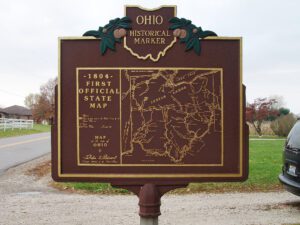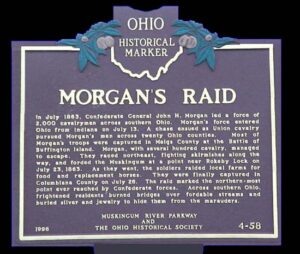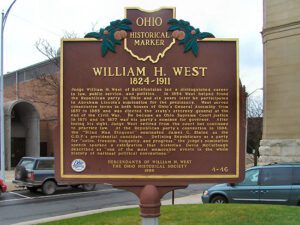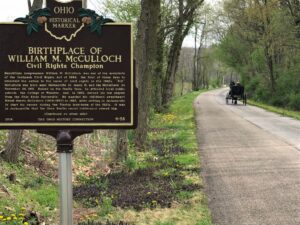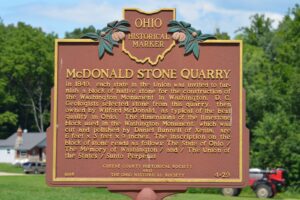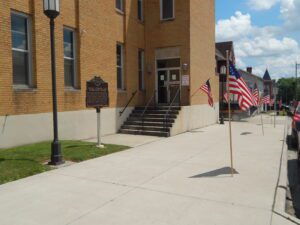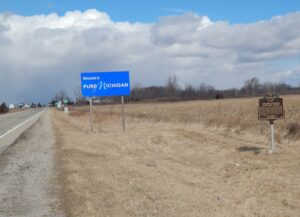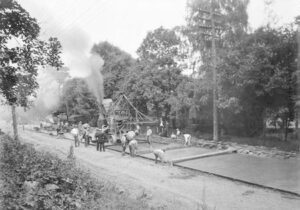, OH
With the signing of the Treaty of Paris in 1783, England lost the American Revolution and ceded to its former colonies land from the Atlantic Ocean to the Mississippi River. By this time, pioneer settlers had reached the eastern bank of the Ohio River, but the Ohio Country, located west and north of the river, was still considered Indian Territory. The Indian tribes desperately defended their hold on this land. On August 20, 1794, United States forces led by Major General Anthony Wayne defeated an Indian alliance at the Battle of Fallen Timbers fought near modern-day Toledo. One year later, on August 3, 1795, the largest assemblage of northwestern Indian representatives at a peace settlement signed the Treaty of Greene Ville, which effectively ceded all land south of the Greene Ville Treaty line to the Americans. The Fort Laurens site was a reference point in the Treaty line. The Ohio Country was then rapidly settled, and in 1808, Tuscarawas County was organized.
, OH
In July 1863, Confederate General John H. Morgan led a force of 2,000 cavalrymen across southern Ohio. Morgan’s force entered Ohio from Indiana on July 13. A chase ensued as Union cavalry pursued Morgan’s men across twenty Ohio counties. Most of Morgan’s troops were captured in Meigs County at the Battle of Buffington Island. Morgan, with several hundred cavalry, managed to escape. They raced northeast, fighting skirmishes along the way, and forded the Muskingum at a point near Rokeby Lock on July 23, 1863. As they went, the soldiers raided local farms for food and replacement horses. They were finally captured in Columbiana County on July 26. The raid marked the northern-most point ever reached by Confederate forces. Across southern Ohio, frightened residents burned bridges over fordable streams and buried silver and jewelry to hide them from the marauders.
, OH
Judge William H. West of Bellefontaine led a distinguished career in law, public service, and politics. In 1854 West helped found the Republican party in Ohio and six years later he participated in Abraham Lincoln’s nomination for the presidency. West served consecutive terms in both houses of Ohio’s General Assembly from 1857 to 1865 and was elected the state’s attorney general at the end of the Civil War. He became an Ohio Supreme Court justice in 1871 and in 1877 was his party’s nominee for governor. After losing his sight, Judge West retired from the court but continued to practice law. At the Republican party’s convention in 1884, the “Blind Man Eloquent” nominated James G. Blaine as the G.O.P.’s presidential candidate. Defining Republicans as a party for “union, freedom, humanity, and progress,” the judge’s nomination speech sparked a celebration that historian David McCullough described as “one of the most memorable events in the whole history of national political conventions.”
, OH
Republican congressman William M. McCulloch was one of the architects of the landmark Civil Rights Act of 1964, the first of three laws to recommit the nation to the cause of civil rights in the 1960s. “Bill” McCulloch was born near Holmesville to James H. and Ida McCulloch on November 24, 1901. Raised on the family farm, he attended local public schools, the College of Wooster, and, in 1925, earned his law degree from the Ohio State University. He married his childhood sweetheart Mabel Harris McCulloch (1904-1990) in 1927, after settling in Jacksonville to start his career during the Florida land-boom of the 1920s. It was in Jacksonville that the Deep South’s racial intolerance seared him. (Continued on other side)
, OH
In 1849, each state in the Union was invited to furnish a block of native stone for the construction of the Washington Monument in Washington, D.C. Geologists selected stone from this quarry, then owned by Wilford McDonald, as typical of the best quality in Ohio. The dimensions of the limestone block used in the Washington Monument, which was cut and polished by Daniel Bunnell of Xenia, are 6 feet x 3 feet x 9 inches. The inscription on the block of stone reads as follows: The State of Ohio/ The Memory of Washington / and / The Union of the States / Sunto Perpetus
, OH
Ohio’s first female county sheriff, Maude Charles Collins (1893-1972) of Vinton County was appointed to finish her husband Fletcher’s term after he was killed in the line of duty in October 1925. In 1926, she ran for the office in her own right on the Democratic ticket and handily beat males in both the primary and general elections. “Sheriff Maude” investigated crimes, answered calls, patrolled roads, and performed the duties of her office, all while raising five children. She gained national attention for solving an intriguing double murder case in 1926, later featured in Master Detective and Startling Detective magazines. In 1927 she was the first woman to deliver inmates to the Ohio State Penitentiary in Columbus. Collins, a pioneering woman in law enforcement, was inducted into the Ohio Women’s Hall of Fame in 2000. She is buried in Hamden Cemetery.
, OH
After the War of 1812, the United States Congress proposed two million acres of military bounty land for the Michigan Territory. To survey the land, the meridian had to first be established. U.S. Surveyor General Edward Tiffin created the meridian based on the western line of the Treaty of Detroit (1807). He contracted with Deputy Surveyor Benjamin Hough in April 1815 to begin the survey for $3 per mile. Taking a reading from Polaris (the North Star), Hough, Alexander Holmes, and 11 crew members surveyed the line due north from Fort Defiance. The difficult terrain they encountered temporarily halted all surveys in the territory and ultimately led to the bounty land being transferred to the Illinois and Missouri Territories.
, OH
Colonel Ebenezer Zane, one of the founders of Wheeling, laid out the village that became Bridgeport in 1806 on the site of Fort Kirkwood (1789). Originally named Canton, it acquired its present name after the bridge to Wheeling Island was built. The arrival of the National Road in 1818 made the growing town a major portal into the state of Ohio for westbound emigrants, adding to its importance as a port for Ohio River traffic. With the advent of railroads and, later, transcontinental highways, Bridgeport continues to serve as Ohio’s “Gateway to the West.”


